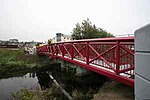| This article needs additional citations for verification. Please help improve this article by adding citations to reliable sources. Unsourced material may be challenged and removed. Find sources: "River Swilly" – news · newspapers · books · scholar · JSTOR (January 2008) (Learn how and when to remove this message) |
| River Swilly | |
|---|---|
 The mouth of the River Swilly near Letterkenny The mouth of the River Swilly near Letterkenny | |
| Native name | An tSúileach |
| Location | |
| Country | Ireland |
| Physical characteristics | |
| Source | |
| • location | Glendore Mountain, County Donegal |
| • elevation | ~15.2 m (50 ft) |
| Mouth | |
| • location | Atlantic Ocean at Lough Swilly |
| Length | ~41.8 km (26.0 miles) |
The River Swilly (Irish: An tSúileach) is a river in County Donegal, Ireland, which flows in an eastern direction through Letterkenny. Letterkenny, the largest town in County Donegal, is built on the river and became the first crossing point on the river in the 17th century.
Name
The river takes its name Súileach ("sharp sighted" or "seeing one"), a multi-eyed man-eating water monster that was reputedly killed by Saint Columba. Letterkenny DJ and producer Diarmuid O'Doherty produced a song, "A Monster in the River Swilly", about this legend.
Course
The River Swilly rises near Glendore, a mountain in County Donegal, and flows for around 41.8 km (26 mi), flowing through Letterkenny, before flowing into the Atlantic Ocean at Lough Swilly. A number of 'burns' flow into the river throughout its course. These include the Forglug Burn, which flows into the river just to the south of Conwal Cemetery, and the Correnagh Burn, which flows under the Derry Road (part of the N56), entering the river at Bonagee on the eastern edge of Letterkenny.
Navigation and use
The river is nearly 42 kilometres (26 mi) long. A shipping industry once operated on the Swilly in Letterkenny. The river was extremely hard for larger ships to navigate, as it was narrow and has many bends near Letterkenny. The port was closed to commercial shipping in the 1960s and its warehouses were demolished in 2001. The coal yard still remains on the old site opposite the Mount Errigal Hotel. Newmills Corn and Flax Mills is powered by the waters of the river.
Fishing
The Swilly traditionally produced approximately 300–400 salmon per year. The heaviest salmon recorded weighed 11 kilograms (24 lb); a sea trout of 5.5 kilograms (12 lb) was also recorded. The river is considered one of the best fishing rivers in the northwest of Ireland.
Crossings
The Swilly is spanned by numerous bridges mostly open to road traffic. In Letterkenny there are four bridges across the river:
| Bridge | Image |
|---|---|
| Oldtown Bridge | 
|
| Port Bridge | 
|
| Rail Bridge | 
|
| Devlin Way | 
|
Devlin Way

Devlin Way, the first pedestrian bridge built over the River Swilly, was opened in Letterkenny in November 2006. It connects the suburban Oldtown area with the town centre. The bridge was designed by TS McLaughlin Structural Engineers and the ironwork was constructed by Bonnar Engineering. It cost €100,000 to construct. A maroon-coloured cambered steel structure which measures 28 metres long and 2.2 metres wide, the bridge is lit by a lamp cast from iron and contains a commemorative stone seat with a plaque. The bridge is a neighbour to the much older Oldtown Bridge. The bridge is named in honour of the Devlin family who live beside the bridge and gave part of their land so that the bridge could be built.
References
- "River Swilly An tSuileach", Reimagining Letterkenny Market Square (PDF), Donegal County Council, retrieved 15 December 2023
- "Swilly Monster". bob.fornal.org.
- MacKillop, James (2004). "Suileach". A Dictionary of Celtic Mythology. ISBN 9780198609674. Retrieved 15 December 2023.
- "Diarmuid O'Doherty - A Monster In The River Swilly". blogspot.com.
- "House Obsessed". blogspot.com.
- Discovery Series (Map) (4th ed.). Dublin: Ordnance Survey of Ireland. 2012. Sheet Sheet 6.
- "Bunnagee (Bonagee) Townland, Co. Donegal". townlands.ie.
- "Donegaltown.ie - Article".
- "First Pedestrian Bridge over the River Swilly". nwipp-newspapers.com. Archived from the original on 28 September 2007. Retrieved 30 December 2006.
External links
| Rivers of Ireland | |
|---|---|
| List | |
| Flowing north | |
| Flowing to the Irish Sea | |
| Flowing to the Celtic Sea | |
| Flowing to the Atlantic | |
| Tributaries of the Shannon | |
| River names in italics indicate rivers which are partially or wholly in Northern Ireland, with the rest being wholly in the Republic of Ireland | |
54°58′N 7°41′W / 54.967°N 7.683°W / 54.967; -7.683
Categories: